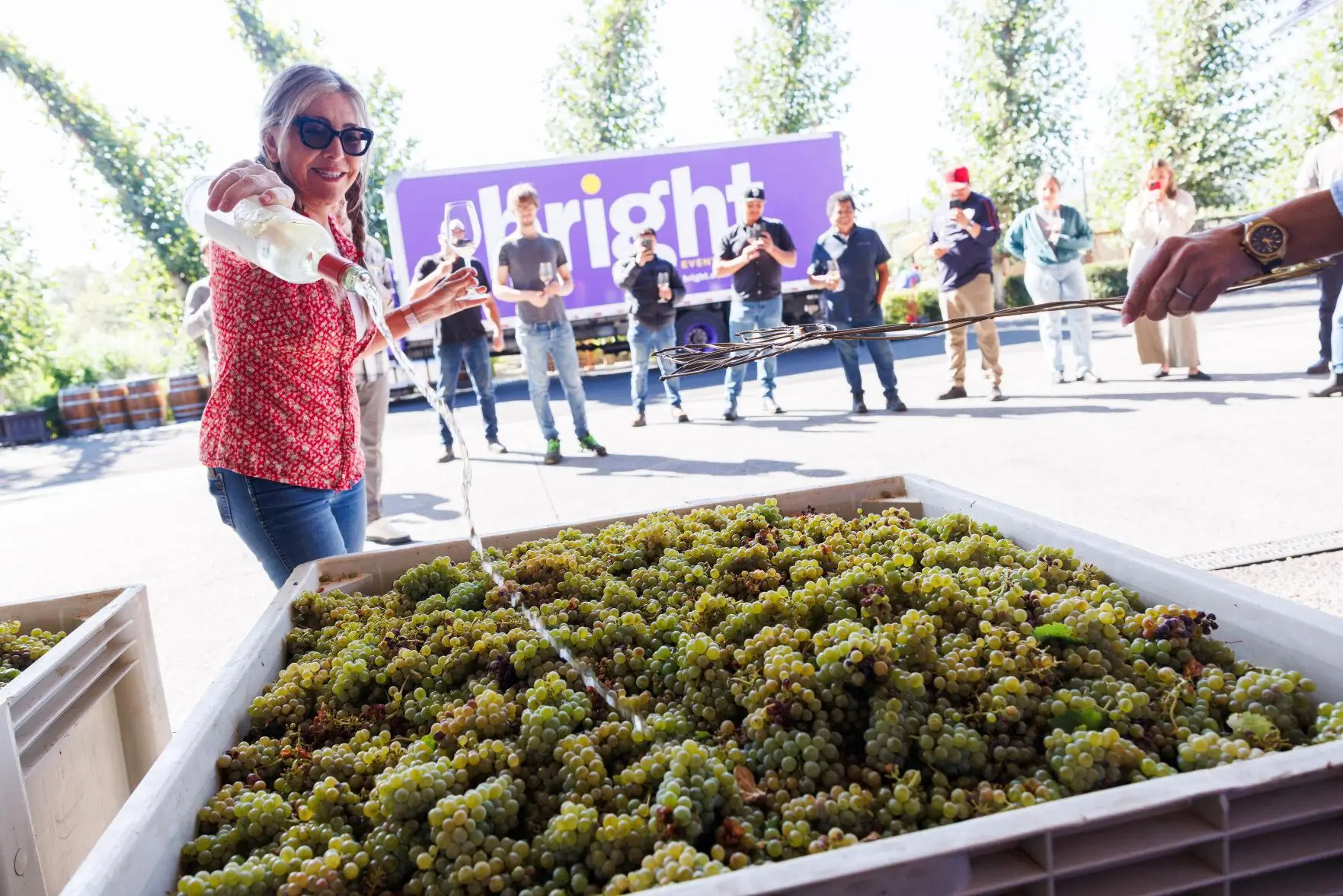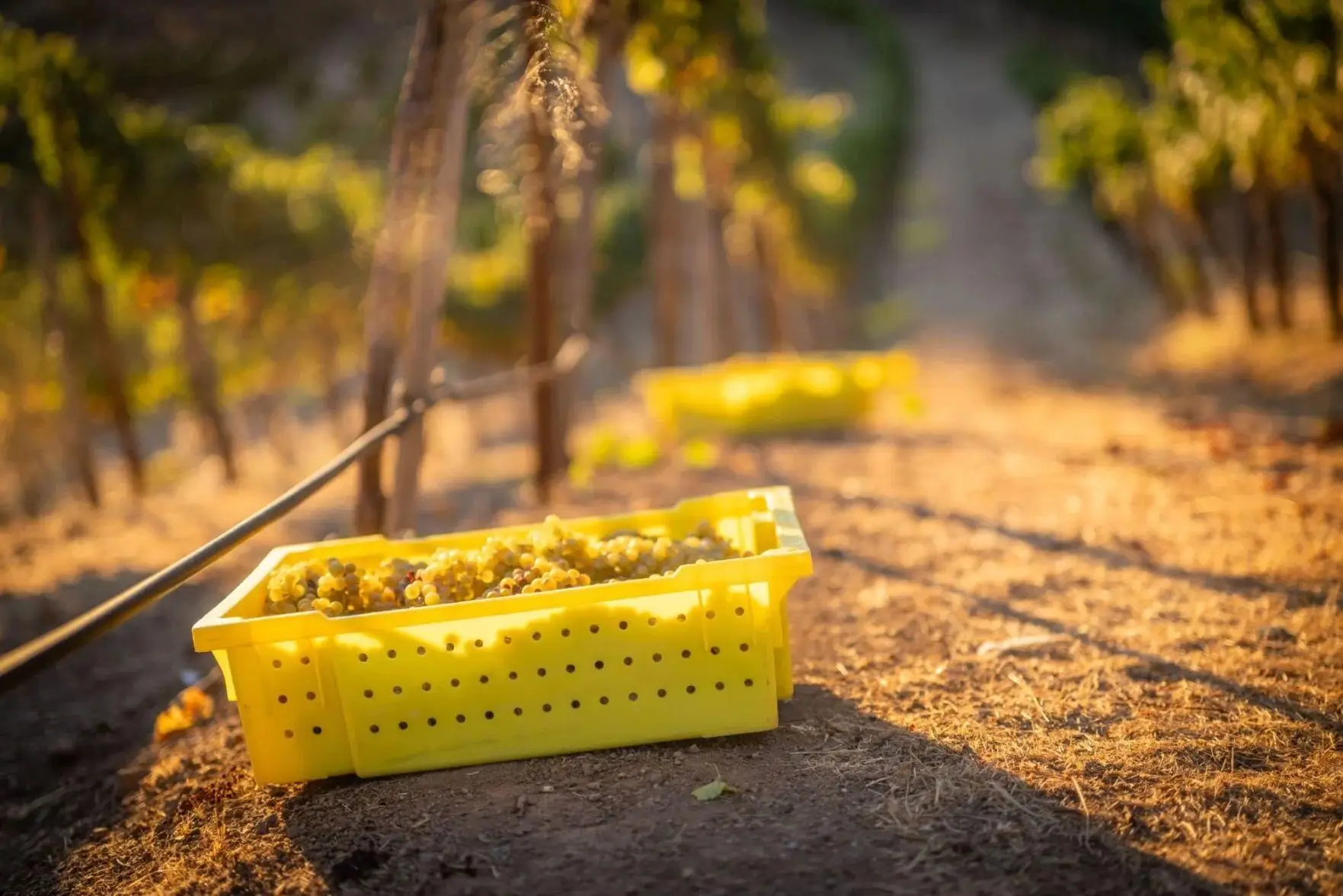Grapegrowers say soil moisture, smart viticulture helped Napa Valley vines endure heat

Growers shared their perspectives on the 2024 vintage during the Napa Valley Grapegrowers’ and Napa Valley Vintners’ joint harvest press conference on Thursday.

Ariana Peju (right), CEO and co-owner of Peju Winery, along with winemaker Sara Fowler blessed the first batch of Sauvignon Blanc grapes on the crush pad of the Rutherford winery on Aug. 6 at the start of the Napa Valley’s 2024 harvest season.
Nick Otto, Register file photo
Matt Stornetta, vineyard manager of Stornetta Made Vineyards Management, counted 38 to 40 days with temperatures of 100 degrees or more, up from eight to 10 days in 2023.
Soil moisture and healthy canopy growth helped the vines withstand the heat, according to Pauline Lhote, winemaking director at Chandon. It helped that the July heat wave hit before veraison, the beginning of grape ripening, thus limiting grapes’ susceptibility to heat damage.
Winemaker Bertus van Zyl of Farm Collective said the early heat wave “set the trend for the season” and primed the vines to endure subsequent hot weather. “The vines looked fine,” he said.
Aside from soil moisture, smart farming practices were a major factor in the vines’ success.
Stornetta said no-till floor management dramatically reduces temperatures, although it’s not suitable for all soil types. Van Zyl pointed to drought-tolerant rootstocks.
Technological advances in the past 15 years have helped Napa Valley growers better understand their vines’ water status, said Richie Allen, senior director of winemaking at Rombauer Vineyards.
“Twenty years ago when it got hot, everyone just irrigated,” Allen said. “Now people are looking at, what does the vine look like? What is its water status? What is our soil moisture like? What is our evapotranspiration like? Does this vine actually need water, or will it be OK?”
The heat made for a harvest that came earlier than it did a year ago — which growers described as the polar opposite of 2024 — but “closer to what we’d call normal,” Allen said. Rombauer started picking on Aug. 12 and finished on Oct. 12, similar to 2018, 2016 and 2013, according to Allen.
The heat accelerated the pace toward the end of harvest. “You had to be pretty careful with your planning for tank space (and) labor,” Allen said.
Yields were roughly consistent with pre-harvest estimates, growers said, varying from vineyard to vineyard depending on varietal and harvest timing. Grapes like Cabernet Sauvignon that were harvested after Labor Day had to endure more heat, which left them lighter than earlier picks, according to Stornetta.

Wesley Steffens, Correlation Photo
On Thursday, Napa growers also addressed the declining market for wine grapes. Sales are “not what they used to be,” Stornetta said.
“We’ve had to really address the situation with our partners,” he said. “How can we work together to find something that allows us to weather the storm mutually? It’s forced us to look at pricing modifications, term modifications, and in the end hopefully it allows for our world-class products to get to the consumer advantageously.”
Allen said he was “getting lots of calls about fruit available” in the spring, and he sped up payments to some growers. As harvest progressed, his phone stopped ringing as often and “it seemed like most of the fruit was getting sold,” he said.
“I haven’t seen much fruit left unpicked,” Allen said. “Napa’s pretty unique in that even in a long market, the fruit is still highly sought after.”
Allen and Lhote said their prices are set by long-term contracts, so they didn’t see prices slide.
Growers agreed that quality won’t be an issue this year.
Van Zyl compared this crop’s concentration, color and intensity to vintages like 2016 and 2019. He said winemakers sometimes joke about intensity as the “stuffing” in a wine.
“There’s definitely a lot of stuffing in (this year’s) wines. A lot of weight,” he said.
“The color is tremendous this year,” Stornetta said. “They’re bold, full wines, a lot of texture.”
“Sauvignon Blanc was very aromatic,” Allen said. “Chardonnay was good concentration, good weight. With the reds we had another classic Napa Valley vintage.”
“Was this a great vintage or was this an exceptional vintage? It’s hard to tell,” Allen added. “But the stars are sort of aligning and it’s another pretty awesome Napa Valley vintage.”
Lhote said the cool nights during the growing season will result in sparkling wines that are “bright and juicy and zesty,” high in acidity and “extremely balanced.”
Finding vineyard labor was “much less of a challenge” than in past years, partly because of the high wages Napa Valley growers can afford to pay, Stornetta said. He said about 98% of the grapes his crew picked were harvested at night, which keeps workers cool and comfortable.
It also makes them more productive, according to Allen, who estimated that crews can pick 10 to 15% faster at night.
Thursday’s press conference was moderated by Kelli White, director of education for The Wine Center at Meadowood Napa Valley.
Source: https://napavalleyregister.com/news/article_19d0dcbc-9221-11ef-a1d6-9fbe618dbe3c.html
